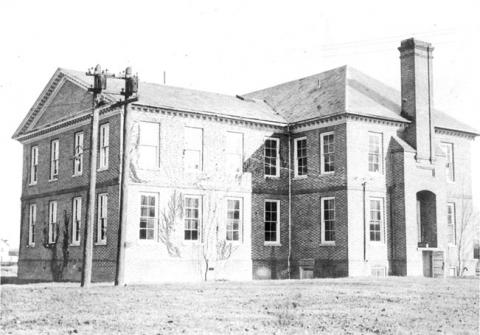
Constructed: 1904-1905
Dedication: April 27, 1906
Demolished: 1932
Map it for me
Note: Location on map is approximate.
The Science Hall was located northwest of the Wren Building. In 1901, President Lyon G. Tyler suggested that William & Mary use the Blodgett legacy (of Earl Walter Blodgett) as a basis for the fund to erect a Science Hall and added that it should be named Blodgett Hall in his honor. The Board of Visitors decided that the $3,000 Blodgett Fund was insufficient for the project and denied the request, so Tyler began fundraising that year for the Science Hall's construction.
A committee was organized in 1903 to consider plans for the erection of the Science Hall and another committee was appointed by the Board of Visitors to secure plans and estimates for its construction (not to exceed $10,000) in 1904. That same year, the Alumni Association initiated a campaign for the "Science Hall Fund of William & Mary College." The plans and specifications for the building were approved in March 1905 and a committee was authorized to close a contract with R.H. Richardson and Son for construction of the Science Hall for $13,720. The contract was signed on May 2, 1905 and Finlay F. Ferguson and Charles J. Calrow were hired as architects for the 78'-by-78' building. The building was completed by December 1905, and dedication and opening ceremonies for the Science Hall were held on April 27, 1906.
A faculty room, the Registrar's office, and a lecture room for American History and Politics were added to the Science Hall in 1909. An ornamental drinking fountain was installed in front of the building in 1912. In 1916 the Political Science classroom was divided into two labs: one for Physics III and one for Chemistry III. The Political Science Department was moved to a room on the first floor of the main College Building (see Wren Building). In 1917 a Tirril Gasoline Gas plant was installed in the basement of the Science Hall to supply laboratory burners.
In 1919 the registrar's office moved to the Main Building (Wren Building). Biology classes were moved to the Penniman Building in 1921. In 1922 the Science Hall housed Physics, Home Economics, and part of the Chemistry Department. Chemistry moved to a temporary building on the west side of campus in 1923. In 1924 the Philosophy and Psychology Departments moved into the Science Hall. The Biology Department returned to the building in 1925.
The building was renamed Ewell Hall after the Ewell Dorm was torn down in the summer of 1927. At that time, the building housed Home Economics and all the science lecture rooms and laboratories except for Chemistry. The Physics and Chemistry Departments moved to Rogers Hall in 1928 and Biology moved to Washington Hall in 1929. The Departments of Home Economics and Music moved into Ewell Hall that same year.
Charles M. Robinson, the College Architect, described the Science Hall's appearance in the following way (circa 1927) "While it is laid in Flemish bond, the brickwork is fiery red in color, and is out of harmony with all else on campus."
The Science Hall held classes for Home Economics and Music as well as classes for shorthand and typing during 1930 and 1931. The building was torn down in the fall of 1932.
Photographs
- 1906--Catalog, p. 30
- 1906--Colonial Echo, p. 51; 1907--Colonial Echo, p. 96 (interior photos); 1922--Colonial Echo, p. 23
- Nov. 1909--Bulletin, Vol., Ill, No. 5, has physics lecture room and Chemistry Lab.
